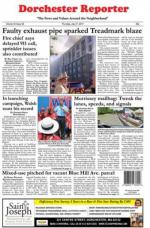October 22, 2009
When I was a boy and then a young man I hung out at a playground situated on just over two acres in the middle of St. Mark’s parish in Dorchester. It was set off by streets named Melbourne to the east and Brent to the south and Wainwright to the west. To the north behind the basketball/tennis court, the bath house, and a children’s play area, a multi-family block of housing known as the Frederick building and a few residences completed the square that was identified on the city of Boston’s books as the J.J. Cronin Playground.
To those of us who treated it as our home-away-from-home, it was Wainwright Park, or, better, the “Wainie,†and Charley Paget, a man of gnome-like presence occasioned by a bout with polio in the World War I years, was in charge, representing the city in the administration building where he spent every day and every evening for more than four decades. On the field and courts, he swept up trash and stones, raked and burned leaves, and laid down the chalk lines for baseball and softball games. In the winter, he presided over a man-made pond; the city flooded the field after Thanksgiving, and when the seasonal freeze set in, as it always did in those days, skating circles and games of hockey broke out.
Our section of Dorchester was dotted with such setoffs from the two- and three-deckers that lined the streets on both side of Dorchester Avenue – Hemenway Park (the “Hemmieâ€), where St. Mark’s met St. Ann’s, Walsh Park down in St. Gregory’s, the Garvey in Neponset, Town Field at Fields Corner, and Ronan Park up at St. Peter’s.
Down the years of the 20th century it was at these parks that boys and adolescents and near-adult young men (a girl-spotting inside the park in those days was a rarity) gathered to play at baseball (full field and clear-fielding), football, basketball, hockey, handball, roofball, stoopball, halfball, stickball – and, in down times, all varieties of poker. And each group, just about a year younger than the gang ahead, had a name and pretty much kept to itself. In my case, it was the Shamrocks, who followed the Panthers who succeeded the Rebels who followed the Redskins who trailed the Termites.
Every few years or so the oldest gang of Wainie boys-turned-men moved to lives beyond the daily intrigues and pleasures of the park, in most cases with a detour first to two years of service in the military. The draft was a constant from the beginning of World War II up until the late stages of the war in Vietnam, and if anything served as the rite of passage of generations out of the park and into real life, it was the call to serve in uniform. Few returned from the service to hang out as before, though some of us came back regularly to check on Charley, who locked up the building one day in the fall of 1976, walked home to Moultrie Street, and died in his sleep.
The Wainwright Park Rebels of the 1950s held a reunion at the McKeon Post recently, but it wasn’t an exclusive event; wives and girlfriends were on scene, and a few Shamrocks and other outliers also dropped by for the evening.
George Reed, a Rebel pasha who lived on Lithgow Street across from the park, sent out invitations to the reunion using a roster of Rebel-era names that he has kept up over the years. There are about 170 men plus spouses on his list and about 80 came to the Post that night, just about enough to fill the room for small talk, a dinner by Gerard, and some dancing.
To look down George Reed’s roll call is to know that while the Wainie alumni of the 1950s won’t be coming back to play on Charley Paget’s dusty lot, most of them haven’t roamed very far. Of the 170 men listed, 20 now live out of state, with Florida (9) the favored setting, Los Altos, California, the farthest away, and Newfoundland (Harold Bruce) and St. Thomas, VI (Billy Mooney) serving as the exotic locales.
Virtually every other man of the 150 remaining in the Reed catalog is living within a 90-minute drive of Wainwright Park a half-century after their hang-out days in Dorchester. There are 14 families on the Cape, and the rest live predominantly on the South Shore or in Southeastern Massachusetts.
It is a fact of demographics that people from Dorchester who move within state tend to go south or to the near-west suburbs. The Reed listing of stay-in-Massachusetts names reflects that reality clearly: Of those 150 names, 142 live south and southwest of Boston while 8 list addresses to the north of the city.
The Cronin/Wainwright lot remains a park today with soil, sand, and grass to play on, and benches, tables, and courts. It is not as spartan a place as was my Wainie when I was a boy-turning-man, and nowhere near as busy. But it is a place for its time, and here’s to good memories for those who use it well today.


